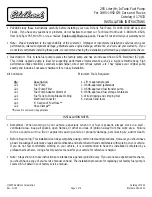
Batteries – Electric Vehicle
IMPURITY
ALLOWABLE CONTENT (PARTS
PER MILLION)
EFFECTS OF IMPURITY
Selenium
2.0
Positive plate shedding
Zinc
4.0
Slight self-discharge of negative plates
BATTERY CARE
To keep batteries in good working condition, follow this maintenance program on a regular basis. Proper battery
maintenance is critical not only for good performance, but also for safe operation.
See following WARNING.
WARNING
• Ensure battery connections are clean and properly tightened.
• Use only 4-gauge (AWG) wires with low-resistance terminals to replace battery wires on IQ Plus
models.
• If battery wire terminals are damaged or corroded, replace or clean them as necessary. Failure to do so
can cause them to overheat during operation and can result in fire, property damage, or personal injury.
1.
Batteries should be kept clean and free of corrosion. Wash tops and terminals of batteries with a solution of
baking soda and water (1 cup (237 mL) baking soda per 1 gallon (3.8 L) of water). Rinse solution off batteries. Do
not allow this solution to enter the batteries. Be sure terminals are tight. Let the terminals dry and then spray
them with Battery Terminal Protector Spray.
See following NOTE.
NOTE:
Dispose of waste water properly.
2.
The electrolyte level in the batteries should be checked weekly
(Figure 16)
. Add water only after charging unless
the electrolyte level is below the top of the plates. In this case, add just enough water to cover the plates, charge
and then check the level again. Never charge batteries if plates are exposed above electrolyte level. For best
battery life, use only distilled water.
See following CAUTION and NOTE.
CAUTION
• Do not overfill the batteries.
NOTE:
A battery watering gun or bottle is available from your authorized Club Car dealer.
3.
The hold-down straps should be tight enough so that the batteries do not move while the vehicle is in motion, but
not so tight as to crack or buckle the battery case. For Villager 6 and 8 vehicles, tighten hold-down retaining
nuts to 55 in·lb (6.2 N·m). The terminal connections should be clean and tight, and any worn insulation or
frayed wires should be replaced. Tighten battery terminals to proper torque.
See Connecting the Batteries –
Electric Vehicles on page 14.
4.
After use, the batteries should be placed on charge. The batteries should never be left discharged any longer
than absolutely necessary (do not leave batteries discharged overnight).
Page 40
Villager 6 and 8 Owner’s Manual
















































